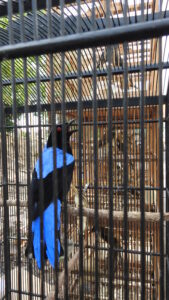Beautiful birds risk trade: Global study reveals how aesthetics drive wild bird exploitation for trade
A new global study finds that the visual beauty of birds – their colours and shapes – predicts which wild species are traded by people. By analysing data for over 9000 bird species, researchers discovered that the birds people find most aesthetically appealing are also more likely to appear in wildlife markets.
“The results show a correlation between a species’ aesthetic value and its likelihood of being traded, particularly in live markets, where birds are commonly sold as pets or for display.”, says Anna Haukka, lead-author of the study.
The study also found that this aesthetic-driven trade varies by region and product type. Visually attractive birds are more frequently traded alive in international markets, while domestic trade shows a weaker connection. Aesthetic appeal also influences the trade of bird products like clothing and ornaments, though it plays a lesser role in markets for meat or traditional medicine.
Beyond beauty, other factors such as body size and geographic range also contribute to a species’ trade risk. Larger birds with wider ranges are more likely to be exploited internationally, while smaller species might tend to appear more often in local markets. “Our findings highlight a troubling pattern: people’s preference for visual beauty may unintentionally increase conservation risks for certain species,” Anna Haukka said. “Parrots, colourful songbirds, and birds of prey—often considered especially beautiful—are disproportionately represented in trade, sometimes at unsustainable levels.”
Understanding drivers of demand in trade informs early conservation efforts
The authors emphasize that understanding how aesthetic appeal influences demand can help predict future trade targets and inform early conservation efforts. They also call for region-specific strategies, noting that policies like the European Union’s wild bird import ban have reshaped market dynamics and the role of aesthetics in trade.
“Perhaps it does not seem surprising that more attractive species are traded more, but the bird trade is dynamic in geography and fashion, understanding what people find attractive in birds for trade will enable us to predict which species might be targeted in the future” says Simon Bruslund from Copenhagen Zoo and coauthor of the study.
Ultimately, the study underscores a critical message: the allure of beauty can come at a steep ecological cost. By illuminating the link between aesthetics and exploitation, the research offers valuable insights for designing targeted conservation measures and demand-reduction campaigns, conservation planning and policy to protect some of the world’s most admired—and vulnerable—bird species.
The study, published in Biological Conservation, combined aesthetic ratings of birds from a questionnaire with trade information from five major international databases covering both legal and illegal trade including the Songbirds in Trade Database (SiTDB) which is co-managed by Copenhagen Zoo.
Original research article: Haukka, A., Jürgens, J., Staerk, J., Lehikoinen, A., Bruslund, S. & Santangeli, A., 2025. Aesthetic values predict bird trade, but the association varies across product types and trade regions. Biological Conservation Volume 313, 2026, 111572, ISSN 0006-3207,https://doi.org/10.1016/j.biocon.2025.111572
Infobox:
 To create the aesthetic dataset for birds, over 6000 volunteers from 78 countries rated photographs of birds through the “iratebirds” online platform, producing a global “beauty score” for nearly every species. This comprehensive measure of aesthetic value goes beyond simple colourfulness to include other traits—such as crests, long tails, or elegant shapes—that humans find appealing. Combined with the unique comprehensive database SiTDB which covers both legal and illegal trade it becomes a powerful predictor of which species could be pressured by especially pet trade activities.
To create the aesthetic dataset for birds, over 6000 volunteers from 78 countries rated photographs of birds through the “iratebirds” online platform, producing a global “beauty score” for nearly every species. This comprehensive measure of aesthetic value goes beyond simple colourfulness to include other traits—such as crests, long tails, or elegant shapes—that humans find appealing. Combined with the unique comprehensive database SiTDB which covers both legal and illegal trade it becomes a powerful predictor of which species could be pressured by especially pet trade activities.
Image: © Simon Bruslund/Copenhagen Zoo
